Lonnie Pacelli's Blog, page 22
October 13, 2022
Free 10/19-20: 17 Tips for Better Team Building Offsites
 Free 10/19-20: 17 Tips for Better Team Building Offsites
Free 10/19-20: 17 Tips for Better Team Building OffsitesGet it at https://amzn.to/2FwzKeM
#freebook #teamwork #leadership #kindle #kindlefire #ebooks #ebook #Kindlefreebooks #Kindledeals #FREE #mustread #goodreads #greatreads #freebie #freebies #kindlebook #ad
Published on October 13, 2022 02:32
Is your project sponsor doing the job? 15 questions to ask to find out
 Excerpted from
Six-Word Lessons to Avoid Project Disaster
Excerpted from
Six-Word Lessons to Avoid Project Disaster
As a young hot-shot information technology (IT) project manager I was convinced that I had it all together. I was bound and determined to show all those more senior to me how to deliver successful projects. It wasn’t until I messed up not one, not two, but three projects simultaneously that I grew up and recognized I wasn’t all that I thought I was. While that period in my professional career was particularly painful, it was also some of the best learnings I could have gone through. Since then I’ve had successes and failures, but the failures became less frequent because I learned to get comfortable with others providing a critical eye on my work and helping with the necessary precision questioning to keep me out of hot water. This is the genesis behind Six-Word Lessons to Avoid Project Disaster .Following are 15 lessons focused on the project sponsor and the questions to ask to ensure active, focused, and engaged project sponsorship.Lesson 1 - There was no project sponsor assigned - A non-existent sponsor translates to poor support from a business organization, particularly when higher-priority work emerges. Question to ask: Does the project have an engaged and committed sponsor who feels the pain of the as-is situation?
Lesson 2 - Sponsor didn't advocate with his organization - A poorly advocated project translates to inconsistent business organization support and confusion as to what the sponsor expects. Question to ask: Has the sponsor effectively communicated the project scope and goals to his/her organization?Lesson 3 - Sponsor lost interest in the project - A sponsor losing interest is usually an indicator of business priorities changing or the sponsor's management having weak interest. Question to ask: Does the sponsor remain committed to the project and his he/she continuing to support the PM and the team?Lesson 4 - Sponsor changed; new one didn’t care - Sponsor change mid-flight can also be accompanied by different priorities or marching orders. Question to ask: Does the new project sponsor care about the project?Lesson 5 - Sponsor wouldn't meet with the PM - Sponsors who don’t make themselves available to a PM typically mean the project is either not important to the sponsor or the sponsor has bigger fish to fry. Question to ask: Is the sponsor cancelling meetings or not making him/herself available to the PM when the PM needs him/her?Lesson 6 - The sponsor kept changing project scope - Unanticipated scope changes from the sponsor typically mean scope is not physically written down and agreed upon or “selective memory” on part of sponsor or PM. Question to ask: Is the scope statement clearly documented and regularly reviewed with the sponsor and PM?Lesson 7 - Sponsor wanted elegance versus "good enough."- Over-polishing the apple on features can contribute to cost and schedule overruns. Question to ask: Are the features meeting the need without additional bells and whistles that are beyond “good enough”?Lesson 8 - The wrong users were on project - Putting the wrong users on a project can create gaps in capabilities that get discovered after solutions late in the development life cycle. Question to ask: Are people accountable for in-scope capabilities represented on the project?Lesson 9 - The sponsor wouldn’t make difficult decisions - Sponsors unwilling to make difficult decisions contribute to solutions that won’t align to to-be business needs. Question to ask: Are there outstanding issues assigned to the sponsor that are going unresolved?Lesson 10 - Sponsor wouldn’t kill project not needed - Priorities change. A project once deemed important may not be important due to shifting priorities or environmental changes. Question to ask: Does the project still address a problem the sponsor and his/her management sees as important?Lesson 11 - Major policy changes needed weren’t understood - Sponsors who don’t understand and act on mandatory major policy changes can create business failures once the solution is implemented. Question to ask: Are policy changes clearly documented and is the sponsor being held accountable for driving the policy change?Lesson 12 - Sponsor got too overconfident with scope - Some sponsors can get overconfident if the project appears successful by squeezing in additional scope items, causing potential issues with delivery if things go wrong at the end. Question to ask: Is the sponsor asking for additional work to be done late in the project which could jeopardize schedule?Lesson 13 - The sponsor didn’t secure the funding - Sometimes funding takes a back seat to getting something done on time. If the funding isn’t secured by the sponsor, the team risks an overrun or unplanned staffing reduction midflight. Question to ask: Has the sponsor secured the funding to get the project done?Lesson 14 - Sponsor wasn’t clear on the problem - Not articulating a clear problem to be solved can lead to increased scope due to chasing “shiny object” problems. Question to ask: Is there a clear, quantifiable problem statement that clearly defines what project success looks like?Lesson 15 - The benefits didn’t justify the cost - The sponsor needs to ensure that the expected benefits support the cost of getting the project done. Ideally a financial analyst develops and certifies the cost/benefit analysis. Question to ask: Is there a clear cost/benefit analysis that is updated at key project milestones to ensure project makes financial sense to do?
Want to know the ten most important attributes of a best-in-class project sponsor? Check out Be a Killer Sponsor .
Lonnie Pacelli
Keynote Speaker | Board Director | Autism Advocate | Author | Project Management Expert | Microsoft/Accenture Veteran
See his books on Amazon.
Published on October 13, 2022 02:32
October 7, 2022
Free 9/12-13: 16 Tips to Become a Best-in-Class Mentor
 Free 9/12-13: 16 Tips to Become a Best-in-Class Mentor
Free 9/12-13: 16 Tips to Become a Best-in-Class MentorGet it at https://amzn.to/2DPYAET
#freebook #teamwork #leadership #kindle #kindlefire #ebooks #ebook #Kindlefreebooks #Kindledeals #FREE #mustread #goodreads #greatreads #freebie #freebies #kindlebook #ad #mentor
Published on October 07, 2022 02:26
New job, now what? Create a practical 100-day plan to start your new gig on the right foot
 So after you've celebrated that new job or promotion, the reality of what you've gotten into sets in. Now what? Where do I start? Who do I talk to? What are the most important things I need to address? Who can I impact if I do something wrong? Who can impact me if they do something wrong? The question list goes on, adding to the stress of taking the new job. Random execution not only translates to focusing on the wrong things, but also dramatically impacts your credibility with your manager, team, and stakeholders. The answer is not to arrogantly come into the job with all the answers, but to come in with a plan to understand the environment, draw conclusions on the most important things to focus on, and develop an execution plan to act on those conclusions. The answer is a 100-day plan. First things first, your plan may not take exactly 100 days to complete. Depending on your situation it may take fewer days, or, if you are stepping into a major crisis, you may have to expedite the plan or do it concurrently with addressing the crisis. Generally speaking, your plan should not take more than 100 days to complete. The rationale is simple; you want to be viewed as someone who takes deliberate, thoughtful action, not someone who takes forever to figure out what needs to be done. If you can get it done faster and do quality work then by all means do so; just be deliberate in your action.
So after you've celebrated that new job or promotion, the reality of what you've gotten into sets in. Now what? Where do I start? Who do I talk to? What are the most important things I need to address? Who can I impact if I do something wrong? Who can impact me if they do something wrong? The question list goes on, adding to the stress of taking the new job. Random execution not only translates to focusing on the wrong things, but also dramatically impacts your credibility with your manager, team, and stakeholders. The answer is not to arrogantly come into the job with all the answers, but to come in with a plan to understand the environment, draw conclusions on the most important things to focus on, and develop an execution plan to act on those conclusions. The answer is a 100-day plan. First things first, your plan may not take exactly 100 days to complete. Depending on your situation it may take fewer days, or, if you are stepping into a major crisis, you may have to expedite the plan or do it concurrently with addressing the crisis. Generally speaking, your plan should not take more than 100 days to complete. The rationale is simple; you want to be viewed as someone who takes deliberate, thoughtful action, not someone who takes forever to figure out what needs to be done. If you can get it done faster and do quality work then by all means do so; just be deliberate in your action.My 100-day plan focuses on six steps as shown in the graphic below, followed by more detail:Develop a 100-Day What/Who/When/Asks PlanIdentify Who Informs, Concurs, and DecidesUnderstand What Works, Is Broken, and Could Be BetterDevelop a What I Learned SummaryCreate a What Actions Do We Need To Take? ListDevelop an Execution What/Who/When/Asks Plan
Note: click on each graphic to see a larger, easier to read picture
 The 100-day plan's purpose is designed to help you do the following:Understand who the key stakeholders are in and around your organization and the roles they playIdentify what is working, not working, and could be working better in your area of responsibilitySummarize what needs to be done and when it needs to be done byCommunicate a clear execution plan of the most important things to focus on, who needs to do them, and when they need to be done by.Establish credibility with your manager, team, and other stakeholders as someone who listens and seeks to understand before taking action.
The 100-day plan's purpose is designed to help you do the following:Understand who the key stakeholders are in and around your organization and the roles they playIdentify what is working, not working, and could be working better in your area of responsibilitySummarize what needs to be done and when it needs to be done byCommunicate a clear execution plan of the most important things to focus on, who needs to do them, and when they need to be done by.Establish credibility with your manager, team, and other stakeholders as someone who listens and seeks to understand before taking action.Following is an explanation of each of the six steps comprising the 100-day plan with an example of how the deliverable should look.
Step 1: Develop 100 Day What/ Who/ When/ Asks Plan
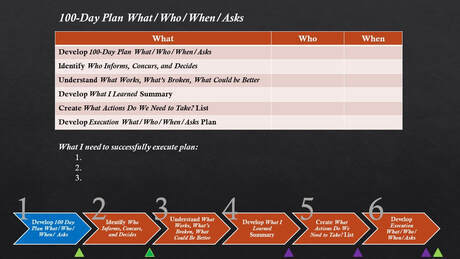 Step 1 is articulate your 100-day plan tasks, who will be performing those tasks, and when you anticipate the tasks being complete. Being "aggressively realistic" is important here; meaning you move the work forward as quickly as you reasonably can while ensuring a quality end product. Once you've determined the what, who, and when of your tasks, articulate any specific requests to your management to help you get the plan executed. Does your plan require travel which requires expense approval? Do you need your manager to provide an introductory email to some stakeholders informing them of your new position and that you'll be contacting them? Think through what those "asks" are then do a plan review with your manager for concurrence and approval. Step 2: Identify Who Informs, Concurs, and Decides
Step 1 is articulate your 100-day plan tasks, who will be performing those tasks, and when you anticipate the tasks being complete. Being "aggressively realistic" is important here; meaning you move the work forward as quickly as you reasonably can while ensuring a quality end product. Once you've determined the what, who, and when of your tasks, articulate any specific requests to your management to help you get the plan executed. Does your plan require travel which requires expense approval? Do you need your manager to provide an introductory email to some stakeholders informing them of your new position and that you'll be contacting them? Think through what those "asks" are then do a plan review with your manager for concurrence and approval. Step 2: Identify Who Informs, Concurs, and Decides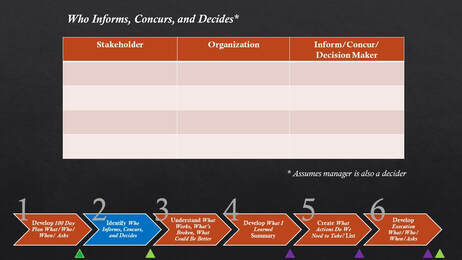 Step 2 is the development of an internal and external list of stakeholders who you want to interview as part of your current-state understanding. Internal stakeholders are those who are within your direct organization including direct reports, extended team members, and other people who impact or are impacted by the work your organization does. External stakeholders are those outside your organization who may or may not be impacted by your work but can provide good information on the current state. External stakeholders also can include experts outside of your company who provide information on industry trends, best practices, or other data points which could help give information about your future direction. For each stakeholder you should identify whether the stakeholder informs you (provides advice but is not directly impacted by your execution plan), concurs with you (doesn't formally approve your execution plan but you want/need their buy-in), or is a decision maker (formally approves your execution plan). I also think it's important to do a checkpoint with your manager as she/he may have additional stakeholders who are functionally or politically important to include, along with their appropriate inform/concur/decide status.
Step 2 is the development of an internal and external list of stakeholders who you want to interview as part of your current-state understanding. Internal stakeholders are those who are within your direct organization including direct reports, extended team members, and other people who impact or are impacted by the work your organization does. External stakeholders are those outside your organization who may or may not be impacted by your work but can provide good information on the current state. External stakeholders also can include experts outside of your company who provide information on industry trends, best practices, or other data points which could help give information about your future direction. For each stakeholder you should identify whether the stakeholder informs you (provides advice but is not directly impacted by your execution plan), concurs with you (doesn't formally approve your execution plan but you want/need their buy-in), or is a decision maker (formally approves your execution plan). I also think it's important to do a checkpoint with your manager as she/he may have additional stakeholders who are functionally or politically important to include, along with their appropriate inform/concur/decide status.Step 3: Understand What Works, Is Broken, and Could Be Better
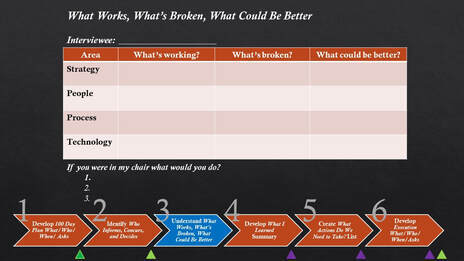 Step 3 is about interviewing your stakeholders to understand what is currently working, what's broken, and what might be working but could work better. This step is vital to not only understanding the current state but to establish a reputation with team members and stakeholders as someone who listens prior to taking action. I've found it helpful to focus on four areas in your works/broken/better discussion: organization strategy, people, processes, and technology. Depending on your situation these areas may be different. The last question I like to ask is, "If you were sitting in my chair, what are the top three things you would you do?" This is particularly effective not only in understanding items stakeholders think are important, but the priority they place on those things they identify. You may customize what you talk about depending on your stakeholder, but it's better to have a structure to work from then alter as needed, rather than totally winging it. Remember to interview your manager to understand his/her top priorities and perspectives. Step 4: Develop What I Learned Summary
Step 3 is about interviewing your stakeholders to understand what is currently working, what's broken, and what might be working but could work better. This step is vital to not only understanding the current state but to establish a reputation with team members and stakeholders as someone who listens prior to taking action. I've found it helpful to focus on four areas in your works/broken/better discussion: organization strategy, people, processes, and technology. Depending on your situation these areas may be different. The last question I like to ask is, "If you were sitting in my chair, what are the top three things you would you do?" This is particularly effective not only in understanding items stakeholders think are important, but the priority they place on those things they identify. You may customize what you talk about depending on your stakeholder, but it's better to have a structure to work from then alter as needed, rather than totally winging it. Remember to interview your manager to understand his/her top priorities and perspectives. Step 4: Develop What I Learned Summary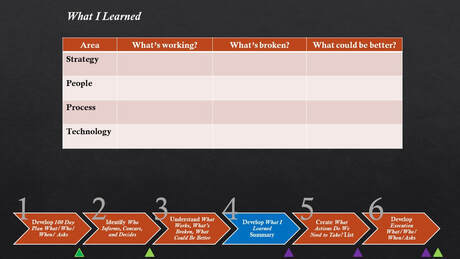 Step 4 is about taking what you've learned through your discussions and documenting trends and important facts that will influence execution plan actions. This is not an audit trail of everything you heard in every discussion; if you do that then you're likely to come out of the exercise with an unwieldy an non-actionable list. Conciseness and clarity are important here as this sets the stage for what you will focus on in your execution plan. You'll also want to do a checkpoint with your concur stakeholders to confirm you are focused on the right working/broken/better items and underscore that you've listened to what others have told you. Again, this is a crucial credibility builder with those you will be working with. Step 5: Create What Actions Do We Need to Take? List
Step 4 is about taking what you've learned through your discussions and documenting trends and important facts that will influence execution plan actions. This is not an audit trail of everything you heard in every discussion; if you do that then you're likely to come out of the exercise with an unwieldy an non-actionable list. Conciseness and clarity are important here as this sets the stage for what you will focus on in your execution plan. You'll also want to do a checkpoint with your concur stakeholders to confirm you are focused on the right working/broken/better items and underscore that you've listened to what others have told you. Again, this is a crucial credibility builder with those you will be working with. Step 5: Create What Actions Do We Need to Take? List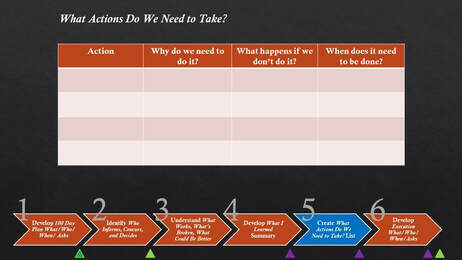 Step 5 begins the translation of what you've learned into what needs to be done to fix what's broken, improve upon what can be done better, and not disturb things that are working well. Each action includes three descriptive pieces of information: why it needs to be done, what the consequence if it isn't done, and when it needs to be done. Through articulating these factors you begin to develop a prioritized list of actions that comprise your execution plan. Do a checkpoint with your concur stakeholders prior to completing your execution plan. Step 6: Develop Execution What/ Who/ When/ Asks Plan
Step 5 begins the translation of what you've learned into what needs to be done to fix what's broken, improve upon what can be done better, and not disturb things that are working well. Each action includes three descriptive pieces of information: why it needs to be done, what the consequence if it isn't done, and when it needs to be done. Through articulating these factors you begin to develop a prioritized list of actions that comprise your execution plan. Do a checkpoint with your concur stakeholders prior to completing your execution plan. Step 6: Develop Execution What/ Who/ When/ Asks Plan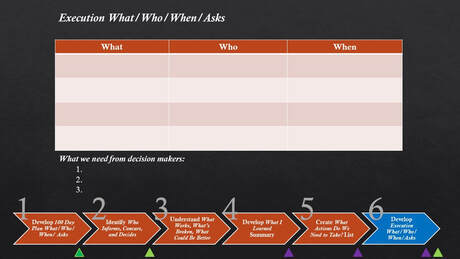 Step 6 is about taking the actions in step 5 and creating a what/who/when plan which facilitates you working on the most important actions and getting them done first. It's totally reasonable to divide your actions up into phases, with your first phase of actions having a more detailed plan and subsequent phases being done once the first phase is complete. I can't stress enough the importance of focusing on the most important items from step 5 first and not getting distracted with trying to plan out all of your actions. In this step you'll do a concur checkpoint to ensure their buy-in prior to doing a decision maker checkpoint. You want to make best efforts to secure concur stakeholder buy-in and avoid having dissenting stakeholders discredit your conclusions and plan.
Step 6 is about taking the actions in step 5 and creating a what/who/when plan which facilitates you working on the most important actions and getting them done first. It's totally reasonable to divide your actions up into phases, with your first phase of actions having a more detailed plan and subsequent phases being done once the first phase is complete. I can't stress enough the importance of focusing on the most important items from step 5 first and not getting distracted with trying to plan out all of your actions. In this step you'll do a concur checkpoint to ensure their buy-in prior to doing a decision maker checkpoint. You want to make best efforts to secure concur stakeholder buy-in and avoid having dissenting stakeholders discredit your conclusions and plan.As mentioned throughout, your situation may require compression or expansion of the above steps. What doesn't change is the understand/conclude/act cycle that you'll need to go through to understand what you're getting into and determine what you need to address, while building trust and credibility with your stakeholders and management. Next time you take on a new job, use this model as a framework to help you execute a practical 100-day plan to get you off to a good start.
Want the PowerPoint slides used in this article? Email me.
Lonnie Pacelli
Keynote Speaker | Board Director | Autism Advocate | Author | Project Management Expert | Microsoft/Accenture Veteran
See his books on Amazon.
Published on October 07, 2022 02:26
October 2, 2022
Status Report Template Download
 Recently I was asked a question about what constitutes a good status report. I've successfully used this basic format for over 20 years on a wide range of projects. If you'd like the word document download here.
Recently I was asked a question about what constitutes a good status report. I've successfully used this basic format for over 20 years on a wide range of projects. If you'd like the word document download here.
Published on October 02, 2022 02:39
Free 10/5-6: 15 Tips to Keep Your Business on Track
 Free 10/5-6: 15 Tips to Keep Your Business on Track
Free 10/5-6: 15 Tips to Keep Your Business on TrackGet it at https://amzn.to/2FxF3L0
#freebook #teamwork #leadership #kindle #kindlefire #ebooks #ebook #Kindlefreebooks #Kindledeals #FREE #mustread #goodreads #greatreads #freebie #freebies #kindlebook #ad #entrepreneur #startup
Published on October 02, 2022 00:00
September 22, 2022
Free 9/28-29: 14 Tips to Unify Your Team to Drive Results
 Free 9/28-29: 14 Tips to Unify Your Team to Drive Results
Free 9/28-29: 14 Tips to Unify Your Team to Drive ResultsGet it at https://amzn.to/2ToVs7r
#freebook #teamwork #leadership #kindle #kindlefire #ebooks #ebook #Kindlefreebooks #Kindledeals #FREE #mustread #goodreads #greatreads #freebie #freebies #kindlebook #teamwork #leadership #followership #planning
Published on September 22, 2022 01:18
I Just Wanna be a PM!
 The Scenario:
The Scenario: Adam, an individual contributor, just finished project-managing another successful project at his company, Conset.
After the project ship party, Adam’s manager asked him to take on a people-leadership role.
Adam was very reluctant to take on a people-leadership role. He just wanted to keep delivering great projects as an individual contributor and didn’t feel comfortable taking on the cultivation of followers.
Adam finally relented, feeling the pressure to fit into the mold of “You must aspire to be a people-leader.”
Six months into the job, Adam was the most unhappy he’d ever been at Conset. He couldn’t spend time delivering great projects like he loved. He was mired down in management meetings, addressing people issues, and trying to craft the vision for his organization.
Adam’s followers grew increasingly disgruntled with Adam’s leadership style and began leaving for other jobs inside and outside of Conset.
Nine months after taking the job, Adam had had enough and left Conset; taking a project manager job at a competitor.
The Message:
Before we get any deeper into this, I want to make something painfully clear: There are leaders I would never ask to project manage a mission-critical initiative, and there are project managers I would never expect to be inspirational people leaders.
There are plenty of project managers who also aspire to be great people leaders. They can paint an inspiring vision and cultivate a high-performing organization to achieve results. They actively understand the goals of their organization’s followers while equipping them to achieve those goals. They excel as inspiring people leaders.
At the same time, I’ve worked with some outstanding project managers who can paint a very straight line between the current and future state, and effectively drive team execution to successful completion. They aren’t particularly charismatic or good at imagining a tomorrow, and they aren’t especially good people cultivators. They are simply good solid project managers.
And that’s completely OK.
All too often, leaders expect that others, particularly project managers, should aspire to be inspirational people leaders. It’s as if being “just a project manager” is somehow less important or doesn’t utilize them to their full potential. Putting (or even worse, shaming) a project manager who just wants to manage projects in an inspirational people leadership role is not only potentially damaging to delivering results, it also carries the potential to adversely impact careers. Not every inspirational people leader wants to be a project manager, and not every project manager wants to be an inspirational people leader.
Project managers and leaders share many of the same attributes, such as great communication skills, removing roadblocks, providing clarity, accepting accountability, sharing praise, and problem-solving. At the same time, I see three key areas where leaders and project managers have different but complementary skillsets, as follows:
Great leaders must define vision; great PMs must execute vision – Great leaders are able to articulate what could be, thinking outside of the box and imagining a new and innovative way to solve a problem. Great project managers need to be able to understand the vision, define a clear path from current state to future vision, identify and alleviate roadblocks, and deliver the vision.Great leaders must cultivate people; great PMs must optimize for results – Great leaders are able to cultivate and grow people to their greatest potential. Great project managers need to ensure the right people are doing the right things to get the right result and adjust when team staffing issues occur.Great leaders must charismatically inspire; great PMs must intentionally execute within cost, schedule and scope – In painting the vision, great leaders know how to invoke passion and excitement to align followers and motivate them to perform. Great project managers need to complement a leader’s ability to inspire with believability through effective delivery within cost, schedule, and scope constraints.
The Consequences:
Assigning an unequipped or unwilling project manager to a people leadership role can result in the following:Visionless organization – Putting a project manager who doesn’t possess a visionary skillset could result in an organization that doesn’t keep pace with the future and doesn’t articulate a compelling “what could be.”
Unhappy followers – It’s only a matter of time for followers who aren’t inspired, challenged, and cultivated to become unhappy with their leader.
Apprehensive project manager – Having a project manager fail in a leadership role due to the project manager being neither equipped nor having the desire to lead can shake his or her confidence and impact future delivery.The Next Steps:
Are you a project manager who is contemplating or being asked to take on an inspirational people leadership role? Consider the following next steps:
Honestly assess your visionary, people-cultivation, and charismatic inspiration skills and document skill gaps.Ask a trusted advisor to review your assessment and skill gaps.Decide if any of the skill gaps are areas where you can and want to grow.If you decide to proceed with taking on a leadership role, put a plan in place to address the skill gaps.Monitor your skill-gap plan and use your trusted advisor to help you with any needed course corrections.
Effective project managers are highly sought after and can be worth their weight in gold in driving on-time, on-budget, and within-scope delivery. If you just wanna be a PM like Adam, then don’t fall victim to thinking “you need to be a people leader.” You don’t. Just keep delivering great projects.
Want to see more about scaling up as a leader? Check out Six-Word Lessons on Scaling Up as a Leader.
Lonnie Pacelli | Building Thriving Leaders™ | See me on Amazon
Published on September 22, 2022 01:18
September 15, 2022
Free 9/21-21: 12 Reasons Not to Start Your Own Small Business
 Free 9/21-22: 12 Reasons Not to Start Your Own Small Business
Free 9/21-22: 12 Reasons Not to Start Your Own Small BusinessGet it at: https://amzn.to/2OSqG36
#freebook #teamwork #leadership #kindle #kindlefire #ebooks #ebook #Kindlefreebooks #Kindledeals #FREE #mustread #goodreads #greatreads #freebie #freebies #kindlebook #ad #entrepreneur #startup
Published on September 15, 2022 02:41
The Straight A’s of Intentional Leadership
 The Scenario: Vera and Tam have just left their manager Walt’s office.
The Scenario: Vera and Tam have just left their manager Walt’s office.“Did you get what Walt wants us to do?” Vera asked.“Nope, as usual. We must have asked him five times to explain what he wanted and why it was important. Just got word salad. Again.”“And were we supposed to do something? He just kept saying ‘the team’. That could be any of several of us. Are we supposed to communicate it out to everyone else?”Tam smirked. “Then he launches into a diatribe of how we’re supposed to do our jobs. And I’ve got no idea not only of what he wants but when he wants it by, or even how to prioritize it with the 30 other things on my to-do list.”Vera nodded her head. “You know how it is, he blathers for a while then forgets he even asked for something. Just stay low and do nothing, this too shall pass.”“Agreed,” Tam said as he pushed the elevator button. “Thai for lunch?”“Yup, then it’s back to getting real work done,” Vera said as the elevator doors opened.The Message:
You may have been in Vera or Tam’s situation; a leader who isn’t clear on what he or she expects followers to do, why it’s important, appropriate advice on how to execute, when it needs to be done, or who is expected to do it. Worse still, perhaps you recognize some of yourself in Walt; a leader who gives fuzzy direction and leaves his followers wondering what in the heck he is talking about.
Through the years I’ve made many mistakes with how I lead others; either being overly prescriptive and turning followers into errand runners or being so vague that followers couldn’t pin me down on what was needed. I’ve learned that good leadership means ensuring clarity on why, what, how, who, and when and ensuring you as the leader don’t over- or under-function in how you lead followers. To that end, I have developed a simple rule I call The Straight A’s of Intentional Leadership, as follows:
Articulate the Why
Align on the What
Advise on the How
Hold Accountable the Who
Agree on the When
Following the straight A rule helps ensure leaders and followers understand why something is important to do, what needs to be done, what constraints need to be considered during execution, who needs to do it, and when it needs to be done. Embracing the straight A rule won’t guarantee great leadership skills, but it sure as shootin’ will help the leader be a better leader and scale up into an intentional leader of leaders.
Interested? Read on for a more thorough explanation of each:
Articulate the Why – Followers want to know that they are spending time on something important. Being clear and precise as to why something needs to be done, the positive impacts of doing it, and the consequences of not doing it are crucial to getting buy-in. Skipping this step or assuming the why is clear to followers will make this a tougher slog for both you and the followers, particularly if tight deadlines accompany the ask.Align on the What – Clear understanding on what the “done” needs to look like is crucial for followers to internalize what the deliverable expectations are. It’s important to be as quantitative as possible and it’s certainly within bounds to share examples if applicable. It’s important to be collaborative and not dictatorial; if followers have an opportunity to influence the deliverable, then they are more likely to own it.Advise on the How – Many leaders are in their position because they have done the job their followers are now doing. Coupled with that experience comes a desire to want followers to do things the way the leader has done it or thinks it should be done. Leaders need to throttle how directive they are with the how considering the following:More experienced followers will generally need less direction; less experienced followers will most likely need more direction.If there are policy, regulatory, or legal constraints dictating why something has to be done a certain way, then the leader needs to ensure the follower understands the constraints and adheres to them.When providing advice to a follower on the how, ensure that it’s clear you are giving advice and that the follower has the option to accept the advice on the how, providing the what and when needs are met.Hold Accountable the Who – Having singularly-named persons accountable for delivery is paramount to ensuring things get done. Putting multiple names or “the team” as the person accountable makes it more likely that things won’t get done because it’s too easy to assume someone else is working on them. If you do need to put multiple names on a deliverable, I like to bold the person primarily accountable for delivery so even if there are multiple people named to work on something, one person is accountable for the resulting deliverable.Agree on the When – Ideally, the accountable followers will set a due date for the deliverable. Many times, though, a date is coming either from above or from a customer. When that happens, the leader should provide guidance to followers:Ensure clarity on the due date expectation and the practical consequences of not hitting the due date.Provide guidance on priority relative to other priorities the followers are working to. If everything is a priority, nothing is a priority :-p.Give the followers an opportunity to assess the work involved and come back to you with what they need to meet the due date.If the due date is truly impossible to achieve, instruct followers to provide what, if anything, can be done by the due date and an alternate plan to meet the what.
The Consequences: Ignoring the 5 A’s when leading followers can mean the following:Missed or delayed dates – Misaligned expectations on the five A’s can lead to deliverables that are late, not done at all, or need rework to meet the need.
Follower frustration – Followers will get frustrated with a leader who doesn’t provide clarity on the five A’s. While it’s incumbent on the follower to ask questions if unclear, the leaders should be proactive in providing clarity in the first place.Poor leader work/life balance – Deliverables missed by followers could spell late nights for the leader to make up for any expectation shortfall.
The Next Steps:
Next time you have a deliverable needing to be done by followers:
Write out an articulated why statement, including the consequences if not done.Have a picture in your mind (or better yet, a sample) of what the deliverable needs to look like.Provide any guidance on how the deliverable needs to be produced, putting particular focus on legal, regulatory, or policy factors affecting delivery.Be clear on who should own the deliverable.
Communicate any date expectations and give the accountable owner an opportunity to understand the work and what can be achieved by the due date.
Want to see more about scaling up as a leader? Check out Six-Word Lessons on Scaling Up as a Leader.
Lonnie Pacelli | Building Thriving Leaders™ | See me on Amazon
Published on September 15, 2022 02:41



